
The Muscle Mass and Strength Building Program
MAP™ is a dietary protein substitute that provides the MAP Master Amino Acid Pattern® (U.S. Patent No. 5,132,113) a unique pattern of essential amino acids in a highly purified, free, crystalline form.
MAP™ is indicated as a safe and effective substitute for dietary proteins.
Clinical studies have shown that the use of MAP™, during physical activity, may substitute dietary proteins or protein supplements in a safer and nutritionally more efficient way to:
- Optimize Body Protein Synthesis
- Optimize muscle mass
- Optimize muscle strength
- Optimize muscle endurance
- Provide a faster an more effective muscle recovery period after physical activity
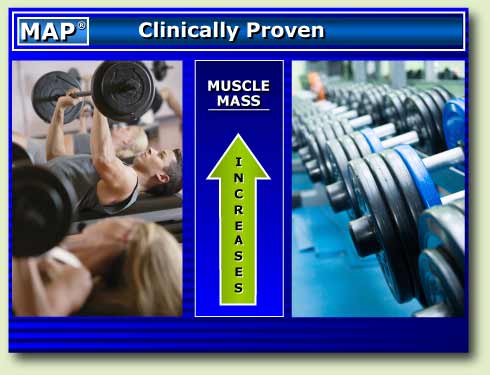
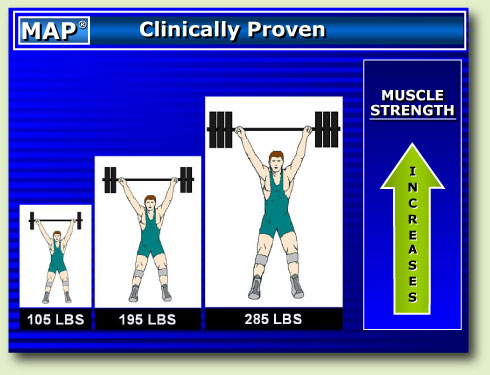
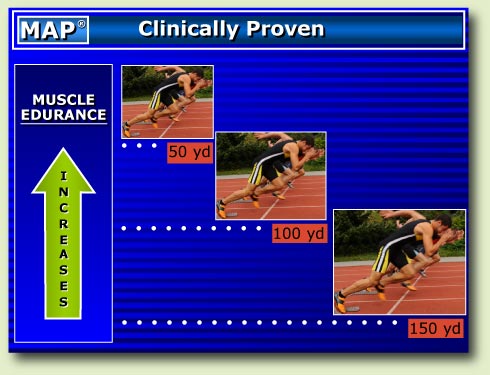

How does the Body’s Muscle Mass and Strength build-up?
The human brain has been programmed for primitive human behavior. As a result, the brain does not perceive physical activity as something desirable. Rather, the brain perceives it as a primitive survival activity necessary for: defending oneself from a threat, building a shelter, looking for food, etc.
While a muscle group is working, it is sending specific signals to the brain, in order to evaluate if the muscle group is fitted for that “survival” activity. If not, then physiological mechanisms are activated in order to increase that specific muscle mass and strength. Thus, enabling it to perform the necessary “survival” physical activity.
However, Body Protein Synthesis (BPS) is required to increase that muscle mass and strength. In order to achieve the Body Protein Synthesis (BPS) necessary to increase that muscle, essential nutrients must be provided, in conjunction with the required vitamins, minerals, trace elements, and essential fatty acids.
Why do most work-out programs fail to increase muscle mass and strength?
They fail because they cannot achieve the body’s positive nitrogen balance necessary to increase muscle mass and strength. This is due to:
Inappropriate Protein Intake.
- Insufficient quantitative protein intake. And/or
- Insufficient qualitative protein intake.
Inappropriate Physical Activity.
- Insufficient quantitative physical activity. And/or
- Insufficient qualitative physical activity.
- Excessive physical activity that does not allow for muscle recovery.
Therefore, to ensure the required body’s positive nitrogen balance to increase muscle mass and strength two factors are simultaneously necessary:
- An adequate quantitative and qualitative protein intake.
- An adequate quantitative and qualitative physical activity.
Why may the use of MAP™ be nutritionally more effective than dietary proteins or protein supplements?
1. MAP™ provides a 99% Net Nitrogen Utilization (NNU).
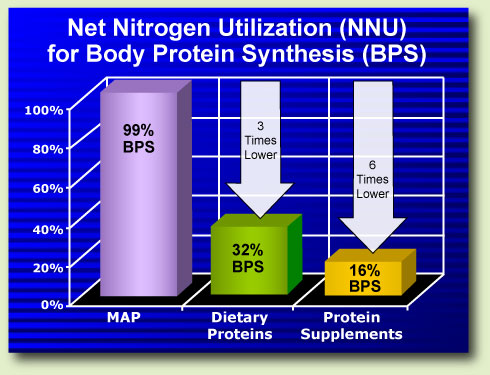
2. MAP™ is absorbed in the small intestine within 23 minutes from its ingestion.
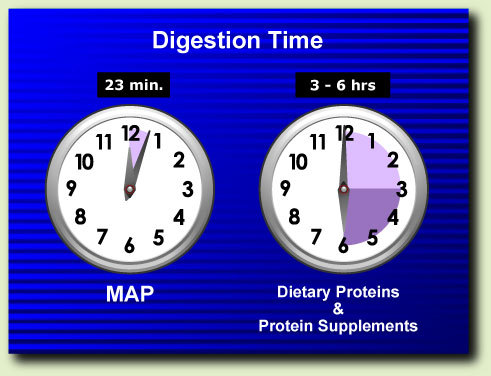

3. MAP™ BPS/min is 99% NNU/23 min.
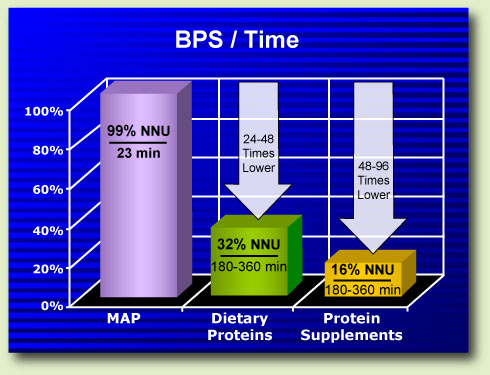
| MAP™ vs. Dietary Proteins & Protein Supplements | |||
|---|---|---|---|
| Characteristics | MAP™ | Dietary Proteins |
Protein Supplements |
| Net Nitrogen Utilization (NNU) for Body Protein Synthesis (BPS) | 99% | 32% (average) | 16% (average) |
| Digestion Time | 23 min | 3-6 hours (6-12 times longer) |
3-6 hours (6-12 times longer) |
| BPS/Time NNU/min) | 99% NNU/ 23 min |
24-48 times lower | 48-96 times lower |
| Released Nitrogen Catabolites | 1% | 68% (average) | 84% (average) |
| Energy | 0.04 kcal/g | 4 kcal/g | 4 kcal/g |
| Fecal residue | Absent< | Present | Present |
| Contraindications | None | Renal Failure or Hepatic Failure |
Renal Failure or Hepatic Failure |
| Adverse Reactions | None | Food Sensitivities | Food Sensitivities |
| Refrigeration | >Not Needed | Needed | N/A |
Why may the use of MAP™ be safer and more convenient, during physical activity, than dietary proteins or protein supplements?
1. MAP™ releases only 1% nitrogen catabolites, namely metabolic toxic waste.

2. MAP™ is absorbed in the small intestine within 23 minutes from its ingestion.

3. MAP™ provides only 0.04 Kcal/g.
4. MAP™ does not produce any fecal residue.
5. MAP™ is amphoteric.
6. MAP™ in contrast with any dietary protein or protein supplement is:
- 100% sodium free. Which may help to control sodium intake.
- 100% fat free. Which may help to control fat intake.
- 100% sugar free. Which may help to control sugar intake.
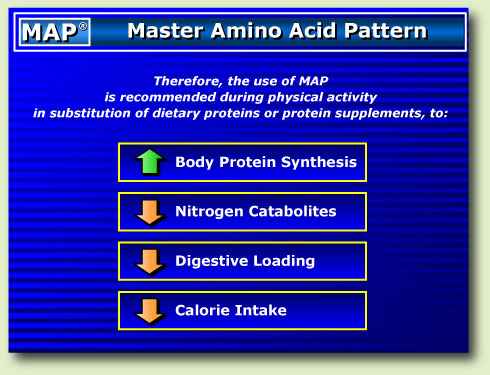
| MAP™ vs. Dietary Proteins & Protein Supplements | |||
|---|---|---|---|
| Characteristics | MAP™ | Dietary Proteins |
Protein Supplements |
| Net Nitrogen Utilization (NNU) for Body Protein Synthesis (BPS) | 99% | 32% (average) | 16% (average) |
| Digestion Time | 23 min | 3-6 hours (6-12 times longer) |
3-6 hours (6-12 times longer) |
| BPS/Time NNU/min) | 99% NNU/ 23 min |
24-48 times lower | 48-96 times lower |
| Released Nitrogen Catabolites | 1% | 68% (average) | 84% (average) |
| Energy | 0.04 kcal/g | 4 kcal/g | 4 kcal/g |
| Fecal residue | Absent< | Present | Present |
| Contraindications | None | Renal Failure or Hepatic Failure |
Renal Failure or Hepatic Failure |
| Adverse Reactions | None | Food Sensitivities | Food Sensitivities |
| Refrigeration | >Not Needed | Needed | N/A |
Why may the use of MAP™, during the required physical activity, be safer and more effective than the use of steroids?
MAP™ vs. Steroids |
||
|
MAP™ | STEROIDS |
SAFETY |
SAFE |
DANGEROUS |
RESULTS |
PERMANENT |
TEMPORARY |
USE |
ALLOWED |
BANNED |
WATER RETENTION |
NO EXCESS |
EXCESSIVE |
MUSCLE DENSITY |
OPTIMIZED |
BELOW AVERAGE |
MUSCLE STRENGTH |
OPTIMIZED |
NOT OPTIMIZED |
Indications & Usage
MAP™ is indicated as a safe and effective substitute for dietary proteins.
Adverse Reactions
No adverse reactions have been ever reported.
Over Dosage
No adverse reactions have been ever reported.
Dosage & Administration
Notice: Individual dosage may vary according to nutritional status, age, gender, and the intensity and frequency of physical activity.
Suggested use for non-athletes:
5 tablets a day (or as directed by a health professional) to be taken during a meal.
Suggested use for athletes:
• For the amateur athlete: 5 to 10 tablets of MAP™, 30-45 minutes before physical activity, in conjunction with the daily requirement of vitamins, minerals and trace elements.
• For the professional athlete: 10 tablets of MAP™, 30-45 minutes before physical activity, in conjunction with the daily requirement of vitamins, minerals and trace elements. And an additional 10 tablets of MAP™ to be taken during the next meal (lunch or dinner).
If taking more than 10 tablets per day, increase dosage gradually. (No more than 10 tablets should be taken within a two hour period).
To calculate the required MAP™ dosage to substitute dietary proteins apply the following equation:
Clinical studies have shown that MAP™ in a dosage of 400mg/kg/day (ideal weight) has been shown to be adequate as a sole and total substitute of dietary proteins to maintain the body’s nitrogen balance in equilibrium. Therefore, to calculate the dosage of MAP™ required to substitute dietary proteins, apply the following equation:
For instance, to calculate the dosage of MAP™ necessary to substitute 10 g of dietary proteins, proceed as follows:
- MAP™ dosage = (Dietary Proteins x 0.4) g
- MAP™ dosage = (10 x 0.4) g
- MAP™ dosage = 4 g
Therefore, 4 g (4 tablets) of MAP™ provide a body’s protein synthesis (BPS) equivalent to that provided by at least 10 g of the most nutritious dietary protein.
How Supplied
MAP™ is supplied in bottles of 120 tablets of 1000 mg for oral administration.
The
Take MAP™ Be a Champion™
Muscle Mass & Strength
Building Program
Caution: Consult your physician before starting this or any other physical activity
Additional information about the Muscle Mass &
Strength Building Program
is available for members.
If you would like to become a member,
please
register here and you will
be emailed a
username and password to obtain access to additional information.
If you are an existing member, please login.
Information on this site is provided for informational purposes and is not meant to substitute for the advice provided by your own physician or other medical professional. You should not use the information contained herein for diagnosing or treating a health problem or disease, or prescribing any medication. If you have or suspect that you have a medical problem, promptly contact your health care provider. Information and statements regarding dietary supplements have not been evaluated by the Food and Drug Administration and are not intended to diagnose, treat, cure, or prevent any disease. Customer reviews are provided for informational purposes only. Customer reviews reflect the individual reviewer's results and experiences only and are not verified or endorsed.
All content ©2010 International Nutrition Research Center (INRC). All rights reserved. No part of this website may be reproduced or distributed in any form or by any means, or stored in a database or retrieval system, without the prior written permission of the INRC.
Physicians' Desk Reference® is a registered trademark of Thomson Healthcare Inc.
